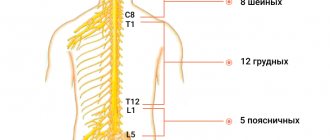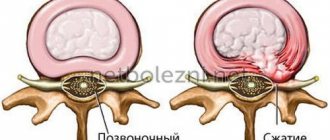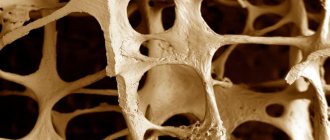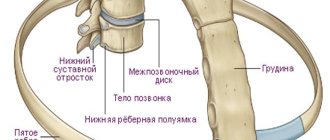Klippel-Feil disease is a rare, severe abnormality of the cervical vertebrae, affecting only one in 120,000 people. It is a hereditary disease. The disease negatively affects the functioning of internal organs, can provoke the development of severe complications and requires long-term treatment.
Such a rare disease as Klippel Feil syndrome is a malformation of the cervical and upper thoracic vertebrae, with the main externally visible sign of the disease being only a short and inactive neck. It is important to note that this, in fact, is not a disease, but a special anomaly of human development, leading to the occurrence of many other diseases of the spine.
Klippel-Feil disease: what is it?
Klippel-Feil syndrome is a genetically determined anomaly of the structure of the cervical spine, including a decrease in the number and fusion of vertebrae. Clinically, it manifests itself as a visually detectable shortening of the neck, a low location of the hair growth line at the back of the head, and limited head movements.
As a rule, Klippel-Feil syndrome is combined with other congenital anomalies of the skeleton and somatic organs. Various specialists are involved in the diagnosis, radiography, CT and MRI of the spine, genetic analysis, and extensive examination of internal organs (heart, kidneys, lungs, brain) are performed. Conservative treatment is carried out through massage, exercise therapy and physiotherapy. Surgical treatment is possible - cervicalization surgery.
The anomaly is often combined with parallel congenital pathologies, such as Sprengel's disease, hypoplasia of the upper limb, or with congenital pathologies of the lung, kidneys or cardiovascular system. The disease occurs in one in 120,000 newborns.
Two French neurologists M. Klippel and A. Feil in 1912 were able to describe a congenital deformity of the cervicothoracic region, which began to occur frequently in children born to parents of the same blood relationship.
It is known that in the Middle Ages close relatives could become spouses. This feature led to the prevalence of the anomaly, which even now has a high frequency of manifestation - one case per 42 thousand newborns.{banner_st-d-1}
Prices
| Disease | Approximate price, $ |
| Prices for hip replacement | 23 100 |
| Prices for clubfoot treatment | 25 300 |
| Prices for Hallux Valgus treatment | 7 980 |
| Prices for knee joint restoration | 13 580 — 27 710 |
| Prices for scoliosis treatment | 9 190 — 66 910 |
| Prices for knee replacement | 28 200 |
| Prices for treatment of intervertebral hernia | 35 320 — 47 370 |
Reasons for development
Pathology is always genetically determined. It is formed during the period of intrauterine development of a person. It is provoked by a mutation of the GDF6 gene, which leads to improper laying of the bones of the spine. There is the following interdependence between the type of pathology and the chromosome responsible for it:
- A section of chromosome 8 leads to the formation of an anomaly of the first type.
- The second type of disease is associated with abnormalities in one of the sections of chromosome 5.
- The third type of pathology develops with problems in the region of the 12th chromosome.
The development of pathology can be monitored using fetal ultrasound as early as the 20th week of pregnancy.
All experts identify hereditary factors that contribute to the occurrence of Klippel-Feil syndrome:
- Genetic hereditary defect in chromosome 12 or 5, 8. In a sick child, there is a complete disruption of the formation of the so-called growth differentiation, which is necessary for the normal further development of the skeleton (including the formation of boundaries between joints and bones). This inevitably leads over time to disruption of the formation and formation of the upper thoracic and cervical vertebrae in the 3rd to 8th week of development inside the womb.
- Autosomal dominant type of inheritance of the disease. With this form of inheritance in a family in which one of the parents is sick, the probability of having a sick child is from 50 to 100 percent. This type of inheritance occurs most often in Klippel-Feil syndrome.
- Autosomal recessive type of inheritance of the disease. In this case, in a family in which one of the parents is sick, the probability of having a sick child is from zero to 50 percent.
Epidemiology/Etiology
GFR is caused by impaired segmentation of the cervical vertebrae in the first weeks of fetal development. There are several hypotheses: vascular disorder, neural tube abnormality, genetic predisposition, and finally facet joint segmentation failure. It is also known that this syndrome can be a consequence of maternal alcoholism or fetal alcohol syndrome. These are just hypotheses. What exactly causes this anomaly still remains unknown.
The incidence of this syndrome is believed to be approximately 0.5-0.7%. However, the exact incidence and prevalence of GFR is unknown due to the lack of population-based screening studies.
Classification
There are 3 types of Klippel-Feil syndrome. Distribution among them is made on the basis of X-ray data.
- Type 1 – characterized by a decrease in the number of cervical vertebrae;
- type 2 – a single monolithic formation is formed, including the occipital bone, the cervical part of the spine and the upper thoracic vertebrae;
- Type 3 – not only the cervical, but also the lower thoracic and lumbar vertebrae are pathologically changed.
Signs
Kleppel-Feil syndrome has 3 mandatory external signs:
- low hair growth line at the back of the head,
- shortened neck
- decreased range of motion.
Let's sum it up
Klippel-Feil syndrome is a congenital anomaly of the upper spine. It is characterized by a triad of external signs and a number of radiological features. The disease has a positive vital prognosis, but it is completely impossible to cure it. Timely surgical intervention can only correct existing external defects. If such a diagnosis has previously been confirmed in close relatives, it is advisable to undergo a full genetic examination before conceiving a child. Be healthy!
Symptoms of Klippel Feil syndrome
The main signs of short neck syndrome are:
- low back hairline;
- shortened neck (brevicollis);
- “proud head position” (the head tilts slightly backward);
- restriction of neck mobility - may not be noticeable if there is fusion of fewer than three vertebrae or if fusion is limited to only the lower cervical vertebrae. Mobility limitations are more noticeable with rotation than with flexion/extension or lateral flexion of the neck.
The following symptoms may also occur, the presence of which is not mandatory, but with Klippel-Feil syndrome they occur quite often:
- scoliosis - sideways curvature of the spine;
- facial asymmetry;
- torticollis (curvature of the neck);
- wrinkling of the skin of the neck;
- high shoulder blade;
- weakness of facial muscles (paralysis);
- cleft palate;
- deafness.
- diseases of internal organs. A large number of people are diagnosed with defects of the heart, urinary and respiratory systems.
- Diseases of the peripheral nerves may occur in the form of involuntary movements of the upper limbs, lumbargia.
Klippel-Feil pathology may be accompanied by non-standard development of any of the limbs:
- Underdevelopment of the thumb - hypoplasia;
- Syndactyly - incomplete fusion of two or more fingers;
- Additional fingers;
- Congenital absence of the ulna;
- Curvature of the feet;
- Hypoplasia of one or two limbs - insufficient development, shortening or absence of an arm;
- Insufficient development of the pectoral muscle.
Statistics:
- In 50-60% of cases, Klippel-Feil syndrome is combined with scoliosis, in 25% of cases - with a bone variant of torticollis. A combination of short neck syndrome with anomalies of the upper limbs (polydactyly, syndactyly, congenital amputations), foot deformities, rib defects, dental anomalies, facial asymmetry, and farsightedness is possible.
- In 45% of patients, dystopia, aplasia or hypoplasia of the kidneys is diagnosed; hydronephrosis and ectopia of the ureters are possible.
- In 25% of patients, congenital deafness is detected, in 20% - cleft palate, in 15% - congenital heart defects (patent ductus arteriosus, VSD, ASD, aortic dextraposition). Aplasia or hypoplasia of the lungs may be observed.{banner_st-d-2}
Differential diagnosis
- Wildervanck syndrome or cervico-oculo-acoustic syndrome. Patients with CFS may experience deafness, so it is important to differentiate CFS from Wildervank syndrome.
- Congenital scoliosis - Many patients with GFS likely have congenital scoliosis.
- Post-infectious/inflammatory diseases of the spine due to acquired spinal fusion.
- Mayer-Rokitansky-Küster syndrome.
- Torticollis (torticollis). It is important to differentiate between muscular congenital torticollis and GFR. More than 20% of patients with GFR have torticollis.
- Sprengel's deformity—exists in 16% of patients with GFR, but may also be present without GFR. Therefore, it is necessary to check whether a patient with Sprengel deformity also has GFR.
Complications
Most patients do not experience any particular difficulties with existing Klippel-Feil syndrome. The main problem is a cosmetic defect. Some patients do not realize that they are carriers of this type of pathology. The remaining patients were recommended to undergo surgical interventions to eliminate the process and prevent the development of complications. The anomaly can provoke the following diseases:
- Too early development of symptoms of osteochondrosis - the disease can lead to pinching of nerve endings and damage to the vessels supplying parts of the brain;
- Instability and excessive mobility of the elements of the cervical spine can be the main cause of death (spontaneous fracture of the spine).
The prognosis largely depends on the severity of pathological changes and the presence of complications from internal organs. It is especially unfavorable in the formation of degenerative processes in vertebral structures.
Physical therapy
GFR cannot be completely resolved with physical therapy. However, physical therapy combined with non-steroidal medications may be helpful in controlling degenerative changes. When a patient has multiple fused vertebrae, the risk of degenerative changes increases due to immobile joints. It is likely that the upper joint undergoes degenerative changes with the formation of osteophytes. This can lead to radiculopathy and/or myelopathy, so the goal of physical therapy is to prevent or delay this damage. If physical therapy does not help, surgical treatment is necessary to relieve compression on the nerve roots.
Diagnostics
If Klippel-Feil syndrome is suspected, the patient needs to be examined by several specialists: geneticist, neurologist, orthopedist, cardiologist, nephrologist, ophthalmologist. The diagnosis is made based on the results of such studies:
- visual examination, palpation of the deformed area of the spine, history taking (determining the presence of similar cases in the family);
- examination of a small patient by a neurologist. The doctor determines the existing mobility of the cervical area, identifies the presence or absence of spinal curvature;
- Ultrasound (heart, kidneys). Manipulations make it possible to determine the presence of any deviations;
- ECG (necessary to assess heart function);
- genetic research, consultation with a neurosurgeon, drawing up a family tree.
- Radiography. If this disease is suspected, an X-ray is taken in two projections and allows you to determine the number of fused vertebrae and the features of their structure.
- CT. The study is carried out for older patients and allows us to track the structural features of the vertebrae.
- MRI. Provides information about the condition of the spinal cord roots, as well as the muscles located at the fusion of the vertebrae.
- DNA testing and consultation with a geneticist.
What does it look like on an x-ray?
Klippel-Feil syndrome on x-ray in two projections
During examination of patients, doctors note the presence of a short and deformed cervical spine. The number of vertebrae may be less than normal. This type of pathology can be diagnosed when synostosis is formed, that is, the cervical vertebrae form a single structure with the upper thoracic and partially with the back of the head. Another variety combines the characteristics of the above, to which are added the thoracic and lumbar vertebrae fused into a synostotic formation.
Patients have a high position of the shoulder blades, the border of the hairline is lower, which is clearly demonstrated by photographs of people with Klippel-Feil syndrome. In addition, limited range of head movements is diagnosed. The presence of additional ribs and incomplete fusion of the vertebral arches are often recorded.
X-rays of the cervical and thoracic spine with Klippel-Feil syndrome can reveal:
- deformed, reduced vertebrae;
- reduction in the number of vertebrae;
- fusion of vertebral bodies together, in which case both a single bone conglomerate and a bone structure with cartilaginous inclusions in the form of underdeveloped intervertebral discs can form;
- curvature of the spinal column with the formation of scoliosis, kyphosis or lordosis;
- the presence of additional cervical ribs, synchondrosis and abnormal position of the shoulder blades.
After carrying out the above-described manipulations, the doctor makes a diagnosis and determines the extent of damage to the vertebrae and internal organs. Based on the data obtained, he decides how to solve the problem.
Treatment
When diagnosing a cervical spine disorder, you should seek advice from a traumatologist and surgeon, but additional examination by a neurosurgeon and geneticist may be necessary.
Treatment of Klippel-Feil syndrome consists of the following measures:
- massage course;
- physiotherapy;
- use of the Shants collar;
- physiotherapeutic procedures;
- drug treatment;
- surgical treatment.
Drug treatment is aimed at eliminating symptoms. Among medications, preference is given to analgesics, since non-steroidal anti-inflammatory drugs cannot eliminate pain.
In some cases, physical therapy, massage, and physiotherapeutic procedures give positive results, but in case of severe radicular pain, doctors resort to surgical intervention.
Surgery
If persistent pain impulses appear and there is no effect from taking modern anti-inflammatory drugs and analgesics, surgical intervention is resorted to. In most cases, it is quite enough to carry out a cosmetic operation - to restore the physiological location of the muscle groups of the body in relation to the area of the shoulder blades. This allows you to significantly reduce discomfort in the neck, somewhat lengthen its parameters, and increase the range of movements.
Particularly severe variants of pathology require radical therapeutic manipulations, for example, modeling of spinal structures using modern implants.
Exercise therapy and exercises in the pool
Conservative treatment of the syndrome includes a course of exercise therapy, therapeutic massage of the cervical spine and the so-called collar area. Exercises are selected individually, based on the patient’s clinical picture. At first, they should be performed under the supervision of a specialist, then you can move on to home exercises. For patients diagnosed with Sprengel-Feil-Klippel syndrome, exercises in the pool help avoid the complicated course of the disease. As a rule, doctors recommend back swimming for young patients. More complex exercises are also selected individually. There are no universal recommendations on the issue of swimming gymnastics.
Forecast
Life expectancy for Klippel syndrome is usually normal as complications are detected before age 25 and treated using surgical and non-surgical approaches.
The long-term outlook (prognosis) varies, depending on the severity of the case and the specific characteristics of the disease. All affected people have multiple cervical vertebrae connected, additional symptoms may vary greatly. People with minor pathologies can lead normal, active lives and have no significant limitations.
Conditions that have severe forms or additional anomalies require careful and regular monitoring by doctors. The prognosis is good if complications and symptoms are treated early. The overall prognosis depends on the type of anomaly. To avoid pitfalls, it is important to have careful assessment, consistent monitoring.
There are no methods for preventing Klippel-Feil syndrome, for this reason it is important for parents to take special care from an early age of the child. At the same time, you need to know that this pathology is not a death sentence and such patients are able to study and lead a normal life.











